Very few paintings in the history of art have so puzzled viewers as Hieronymus Bosch’s The Garden of Earthly Delights. Even in the basking glory of post modernist permissiveness, its meaning is neither clear nor compelling, only murky. In centuries before our own time, the central picture of the triptych must have appeared wildly remote from actual life. It was obscenity or it was mania. Today however, it is not so far removed from our experience. A crowd of naked people stands and sits around, while others ride aimlessly in circles with no destination in sight, and still others swim languidly, or dive, or do gymnastics beside the water. There are no birds, flowers, or fruits….

"Hieronymus Bosch, Garden of Earthly Delights triptych, centre panel - detail 10 (c. 1504-1510, Oil on panel)" Read More: http://commons.wikimedia.org/wiki/File:Hieronymus_Bosch,_Garden_of_Earthly_Delights_tryptich,_centre_panel_-_detail_10.JPG
Imagine there’s no Heaven
It’s easy if you try
No hell below us
Above us only sky
Imagine all the people
Living for today … ( John Lennon, Imagine)
Terry Eagleton:What (Walter) Benjamin meant was that how we act in the present can change the meaning of the past. The past may not literally exist (any more than the future does), but it lives on in its consequences, which are a vital part of it. Benjamin also thought this about works of art. In his view, the meaning of a work of art is something that evolves over time. Great poems and novels are like slow-burning fuses. As they enter into new, unpredictable situations, they begin to release new meanings that the author himself could not have foreseen, any more than Goethe could have foreseen commercial television. For Benjamin, it is as though there are meanings secreted in works of art that only come to light in what one might call its future. Every great drama, sculpture or symphony, like every individual person, has a future that helps to define what it is, but which is beyond its power to determine. Read More: http://www.newstatesman.com/ideas/2009/11/past-benjamin-future-obama a
…The girls’ hair falls straight down their bare shoulders with only a hint of wave. A few black men and women mingle with the white groups, peacefully accepted. The landscape is a phantasmagoria. Does not the whole thing look like a colony of flower people in a collective happening? The innocent, unlined vacuous faces, the bland joy in unanimous nudity, the silly little games with fruit, and above all, the lack of purpose and direction and will power, the absolute denial of any goal in life except the simplest pleasures of immediate existence and untrammeled movement and indiscriminate gregariousness; a portrayal of the Woodstock nation zeitgeist.
…Imagine there’s no countries
It isn’t hard to do
Nothing to kill or die for
And no religion too
Imagine all the people
Living life in peace …
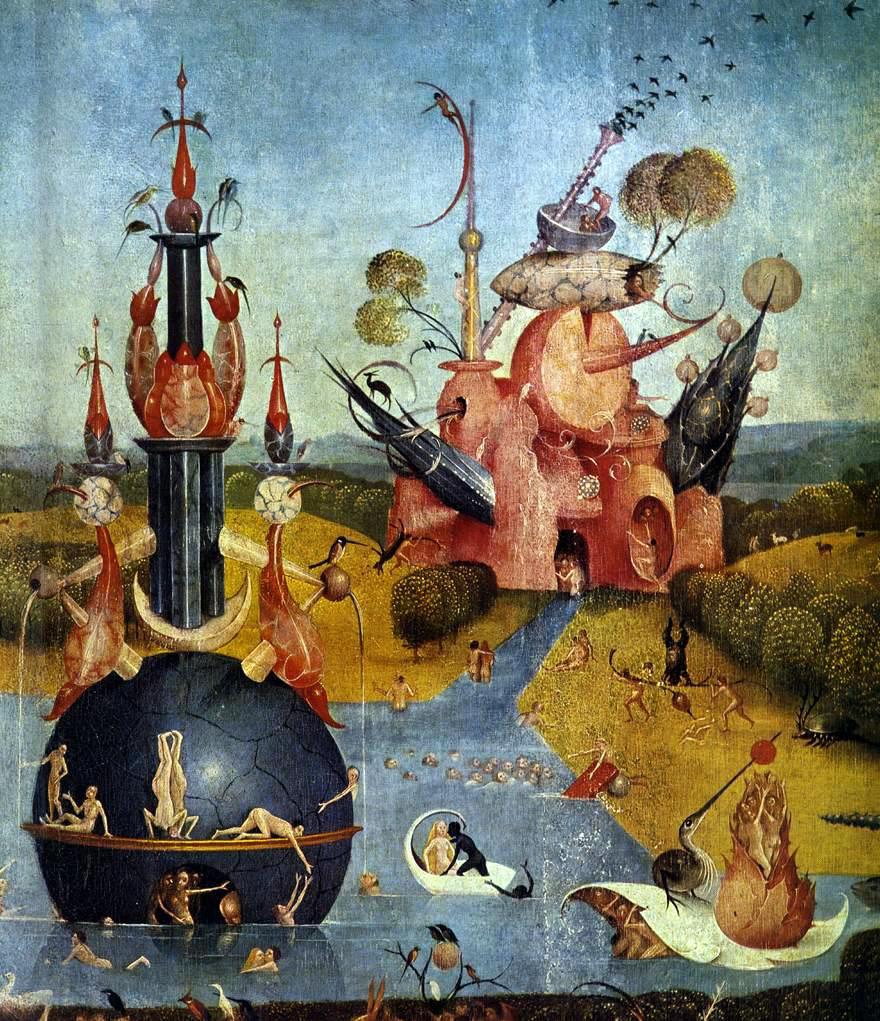
Hieronymus Bosch. The Garden of Earthly Delights, center panel of tryptich (c. 1500). Read More: http://benjaminslure.blogspot.com/2010/05/otherworldly.html
Then what do the strange objects and animals signify? Do they mean anything at all? Many may be sexual symbols that people have long known, but that Freud was the fist to bring within the sphere of intellectual analysis. Yet many simple objects appear to have different and even conflicting meanings. But if we stand back and look at this picture, or at any of Bosch’s fantasies, we shall be compelled to conclude that he intended to puzzle us, to bewilder, and to show us a vision that is as vivid as real life but as irrational as a long-lasting nightmare:
Stanley Meisler:All of Bosch’s paintings pulsate with a lavish symbolism that is obscure today but must have been widely understood five centuries ago. Dirk Bax has pored over antique Dutch plays, tales, poems, maxims, paintings, drawings and prints to unravel the symbolism. In one book, he devoted six long and detailed chapters to the symbols of a single painting, the Saint Anthony Triptych. …But the letter, according to Bax, is in mirror writing, a sure sign that the monster and the fiends are mocking the saint. The monster wears a funnel that symbolizes intemperance and wastefulness, sports a dry twig and a ball that signify licentious merrymaking, and has lopping ears that show its foolishness. All this might have been obvious to the artist’s contemporaries when the work was created, but the average modern viewer can only hope to understand the overall intent of a Bosch painting, while regarding the scores of bizarre monsters and demons as a kind of dark and cruel comic relief. A viewer may also feel a special force or emotion that Bosch did not intend because of the ways in which Western thought has changed in 500 years. This special reaction, in fact, may be the reason why Bosch fascinates…. Read More: http://www.stanleymeisler.com/smithsonian/smithsonian-1988-03-bosch.html a
Apart from the individual images, so many of them incomprehensible, what is the meaning of the whole central picture? What is its significance as the center of the triptych? The most notable fact about it is that there is no religion in the entire scene. Bosch was working about 1510, when most of western Europe was Christian and Catholic, and an infrastructure of churches, and clergy that dominated daily life; but in the world portrayed here there is no religion, neither cross nor altar, neither priest nor parishioner, and even, neither saint nor sinner appear present. It is like a dream of a pagan world: silly, simple, free.
…You may say that I’m a dreamer
But I’m not the only one
I hope someday you’ll join us
And the world will be as one… a
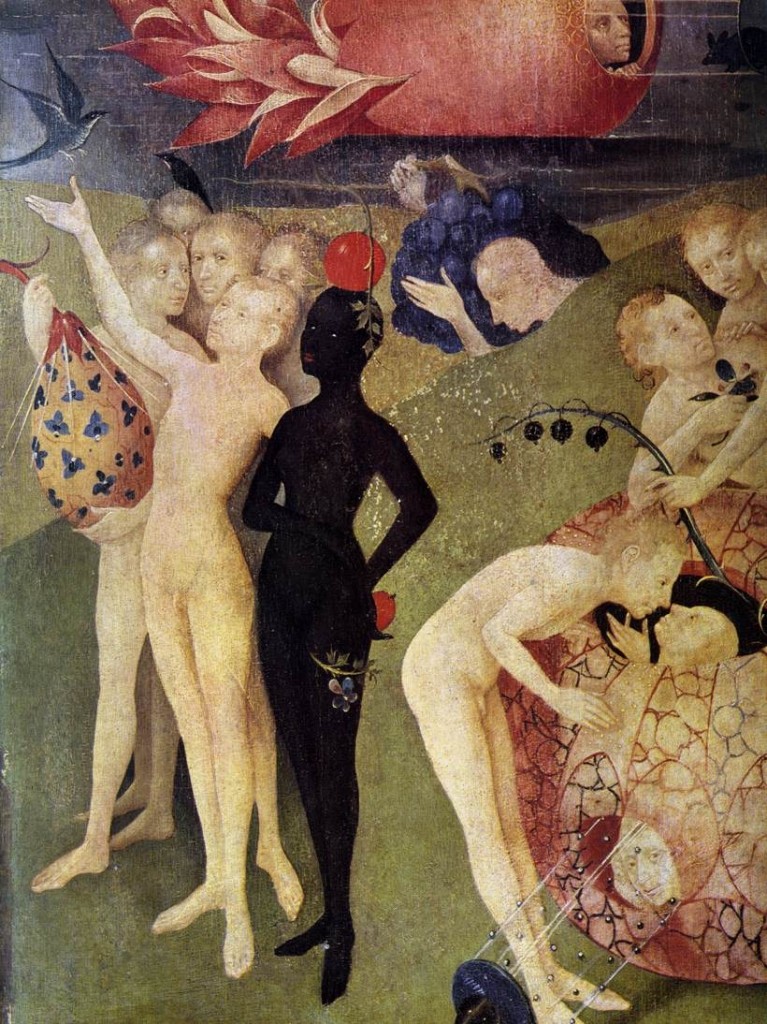
"The picture shows a detail of the central panel, representing the Eulogy of Virility (after Fraenger). " Read More: http://www.terminartors.com/artworkprofile/Bosch_Hieronymus-Triptych_of_Garden_of_Earthly_Delights_central_panel_detail-ca._1500-VI
Then why is it placed in the center of this trio of paintings, with Paradise on one side and hell at the other extreme? What do the three conjoined paintings mean? No one really knows. All solutions to the question are educated guesses. Bosch’s paintings cannot have been executed to convey one simple message; but a general outline seems clear, plausible and coherent.
Humanity is going to hell. We are all doomed. All damned. Secondly, We are not vicious, wicked, repulsive criminals. We are complicit in our doom by being foolish since sin is folly, and not challenging the source of our ills is to submit to it. Thirdly, the mission of Jesus was a perfectly useless exercise, or at best a false flag or a decoy, a bait to be swallowed and then hooked. At the very moment when the human and animal world was created, cruelty and sin were already part of Paradise. This naked society does not believe that Jesus came to the earth to redeem us, it would rather stand in swimming pools and ride griffins than think about repentance and virtue and heaven and hell. It is a world without religion and without memory.
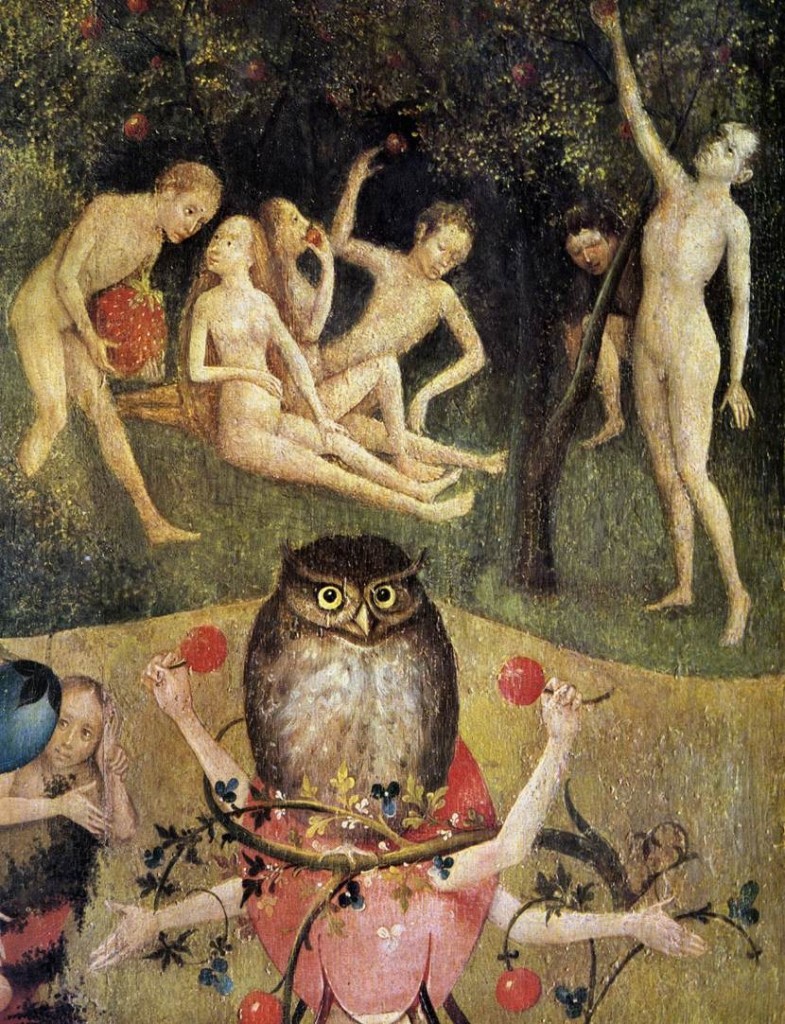
"The picture shows a detail of the central panel, representing the Orange Grove (after Fraenger)." Read More: http://www.terminartors.com/artworkprofile/Bosch_Hieronymus-Triptych_of_Garden_of_Earthly_Delights_central_panel_detail-ca._1500-III
Richard Halperin:… that innocence is manufactured through a process of disavowal—a refusal to own up to or acknowledge what one already knows or thinks or wants. … Disavowal, by contrast, is the refusal to acknowledge those things of darkness that are ours. … For Freud, disavowal is one among several ways of suppressing something unbearable. Repression, another of those ways, banishes unwanted knowledge or desires to the unconscious, where they are no longer available to us. Disavowal, by contrast, involves a “splitting” of the self, so that we simultaneously know and don’t know something. While Freud would not approve, I want to propose an ethical distinction between repression and disavowal…. Read More: http://www.press.uchicago.edu/Misc/Chicago/314405.html
Humankind, therefore, lives in a home for the insane, which, which it has built and equipped for itself. It is ruining its intellect and its power of self-direction. In the end it will hand itself over to the powers of darkness and madness. Eternity will be a lunatic asylum. This is a message of desperate pessimism. Even the darkest of the Christian books in the Bible, Revelation, draws to its end with a battle waged by the Incarnate Word of God against the monstrous beast, the false prophet, and their followers.
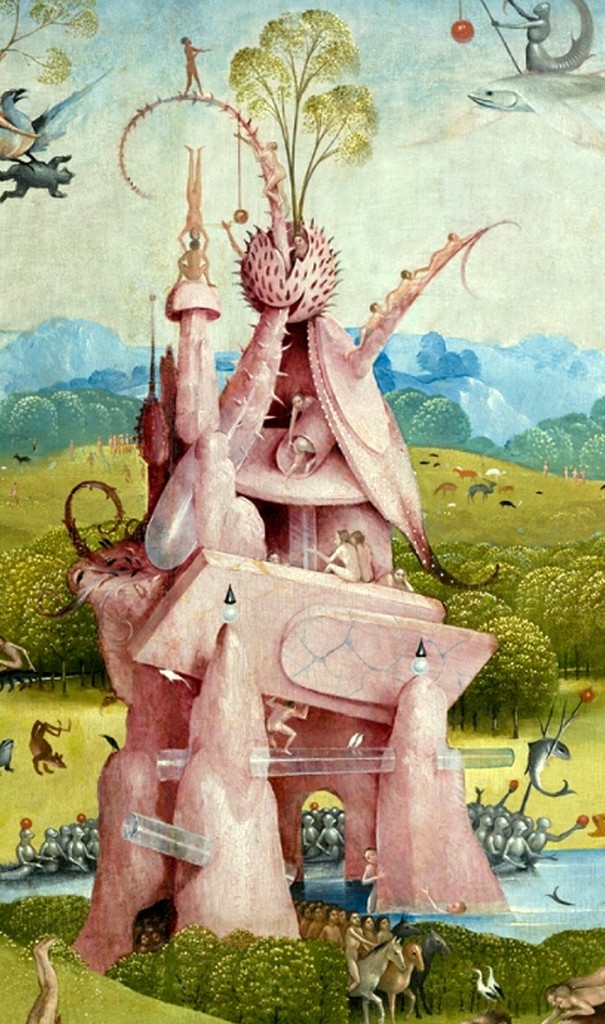
Larry D. Solomon: Some scholars have used an alchemical approach to the symbolism, suggesting that Bosch's images are focused in the alchemy that was practiced in his day. Others have sought to interpret the images in terms of general Christian or Medieval symbolism. There is considerable disagreement on this avenue of interpretation as well. Another route is to use either Freudian symbolism or Jungian archetypes as a basis to explore subconscious connections of which perhaps even Bosch himself was unaware. The dreamlike quality of his images certainly suggests that the last route should be included, or at least considered, in an interpretation. Read More: http://solomonsmusic.net/Bosch_frame.htm
Then comes the last judgment, and after that the radiant vision of the New Jerusalem, gleaming forever with the splendor of the Lord God shed upon his servants. Hell exists for the damned; but some souls are saved, and for them there is a promise of eternal life. Not so in the vision of Bosch, which moves through universal folly to endless damnation, without a hope of heaven.
Halperin: In repression, the conscious mind finds something so objectionable (though also desirable) that it simply expels it and will have no more to do with it. Repression therefore involves, for better or worse, a genuine renunciation. In disavowal, however, consciousness both retains and banishes something. It thereby allows itself to enjoy that forbidden thing on the sly while denying that it enjoys or knows it. … Indeed, it’s a way of eating cake while declaring that people who eat cake are disgusting and ought to be locked up. Disavowal is therefore a short-circuiting of ethics, insofar as it refuses to take responsibility for what one already knows or wants or does, engaging instead in childish forms of denial. It substitutes a false conviction of personal purity for a complex engagement with the self and the world as they really are. While repression divides the self into largely noncommunicating realms of light and darkness, disavowal occupies a murky grey area, neither fully repressed nor fully acknowledged. Read More: http://www.press.uchicago.edu/Misc/Chicago/314405.html
ADDENDUM:
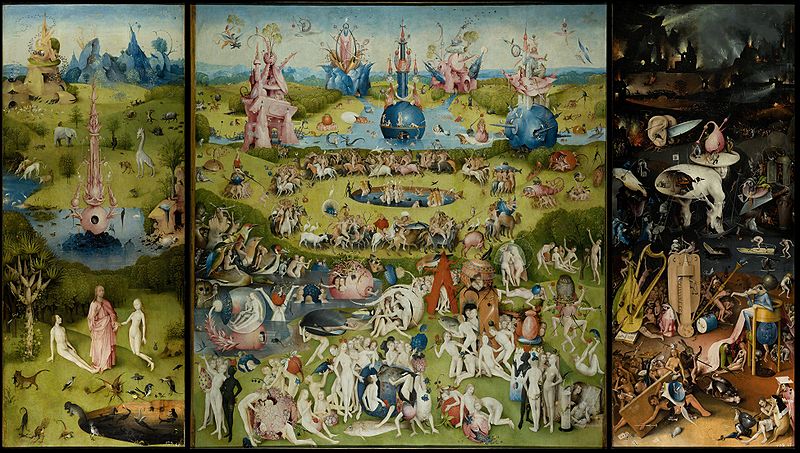
"The first author to leave a specific description of Bosch's composition, Fray José de Siguenza, referred to it in 1605 as 'el quadro del madroño' (the picture of the strawberry), interpreting the gigantic strawberry near the centre as a typically transient object of the senses of smell and taste. E. H. Gombrich refined this interpretation by suggesting that the people depicted are intended to be those who lived before the Flood: a popular mediaeval text, the Historia scholastica of Peter Comestor (twelfth century) states that the earth was less fertile after the Flood than before, when fruit and flowers had grown to enormous sizes (as in Bosch's picture) and mankind had been vegetarian. Other interpretations have found alchemical, astrological or millenarian lore in the picture, while yet others localize it in a feature of Bosch's time, the outburst of moralistic mockery of the self-indulgent mob ..." Read More: http://www.nicepaintings.org/works/90725 image: http://en.wikipedia.org/wiki/File:The_Garden_of_Earthly_Delights_by_Bosch_High_Resolution.jpg


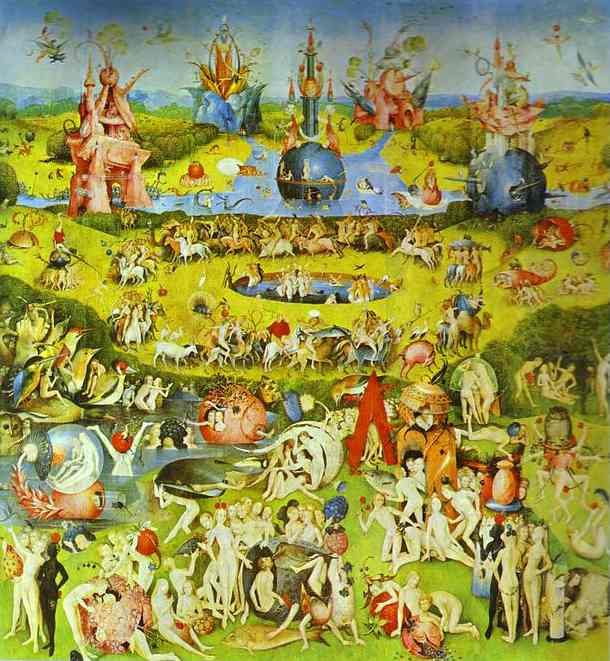
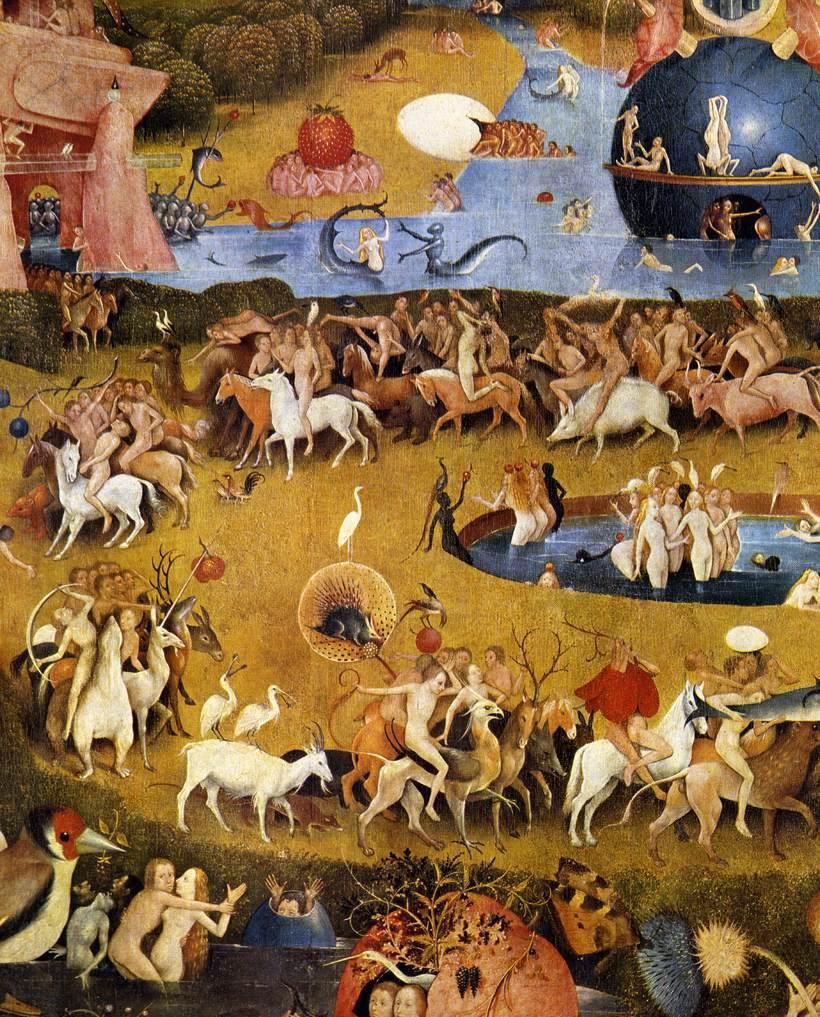



 COMMENTS
COMMENTS